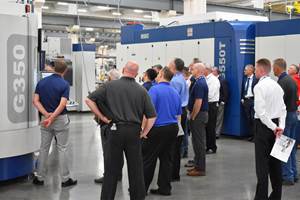Alternate Tool Material For Hogging Large Workpieces
Shops often use either carbide or high speed steel cutting tools for hogging out the large workpieces common to the aerospace and moldmaking industries. While both materials have their advantages and disadvantages, cutting tool manufacturer Precision Cutting Tools says powder metal combines the best features of both. Â
Share





Attaining high metal-removal rates is a priority for many manufacturers, especially those serving the aerospace and moldmaking industries. Although carbide and high speed steel (HSS) cutting tools are popular for roughing applications on the large components common to such shops, both have disadvantages, notes Ivan Salazar, marketing manager for Santa Fe, California-based Precision Cutting Tools (PCT). He says roughing with carbide tools can be difficult because carbide can be somewhat brittle, chipping and breaking at high feeds and speeds. And while HSS is less prone to chipping, it can soften and wear at the high temperatures generated by heavy cuts, especially in applications involving titanium and other exotic alloys that have low heat-transfer rates.
PCT offers another alternative. Mr. Salazar says powder metal tools combine the best features of carbide and HSS. According to Mr. Salazar, powder metal can outperform both materials in rough-milling applications where the goal is to hog out as much metal as possible as quickly as possible.
Compared with HSS, powder metal provides higher heat and wear resistance, lasts longer and is only moderately more expensive, Mr. Salazar explains. Carbide, on the other hand, is harder than powder metal, making it the better choice for finishing applications in which the goal is to produce the smoothest possible surface. However, carbide’s extreme hardness makes it more susceptible to shock. Powder metal is more flexible, allowing users to run at higher feeds and speeds without worrying as much about breaking the tool. Additionally, powder metal tools are less expensive than their carbide counterparts, Mr. Salazar says.
Powder metal’s advantages stem primarily from the fact that its composition is designed to reach a fine balance between hardness (the material’s resistance to chipping or breakage) and toughness (the material’s resistance to gradual wear). Each tool consists of a soft matrix that acts like a glue to hold carbide cutting particles together, says Dave Reau, PCT’s quality control manager. Because the matrix is softer than the carbide particles, the volume of matrix versus the volume of carbide determines the tool’s hardness and toughness characteristics.
Powder metal tools are less brittle than their carbide counterparts because the matrix volume is greater than the carbide volume, while this relationship is reversed in most carbide tools, Mr. Reau notes. He says the tools are more wear-resistant than their HSS counterparts because the carbide particles are more uniformly distributed. This is beneficial because fractures can move through the tool more readily if the carbide particles are aligned, which is common in conventional HSS, he adds.
"Under a microscope, powder metal looks like sand—it mixes together quite finely." Mr. Salazar explains. "Conventional HSS, on the other hand, looks like veins of wood. It’s not quite as compressed and not quite as homogenous."
Powder metal tools can be used for workpieces ranging from aluminum mold cavities to large aerospace components made of titanium, Waspalloy, Hastalloy and other exotic alloys. Materials in the powder mixture are carefully proportioned according to each tool’s intended application. For example, PCT’s PM 30 and PM 60 series contain higher percentages of cobalt for machining hard materials, whereas the company’s PM 4 line includes more vanadium for aluminum workpieces.
Related Content
Sandvik Coromant Inserts Provide Stable Turning of Aerospace Components
The new insert grades GC1205 and GC1210 cover a large application area within last-stage machining and intermediate-stage machining when turning aerospace engine components.
Read MoreShop Tour Video: From Garage Shop to Leading Aerospace Supplier
From repairing aircraft interiors to manufacturing medical implants, Superior Joining Technologies excels at CNC machining, TIG welding, laser welding, and NADCAP-accredited nondestructive testing. Discover how this Rockford-based company supports the aerospace industry through a combination of advanced technologies.
Read MoreGrob Systems Inc. to Host Tech Event With Industry Partners
The 5-Axis Live technology event will highlight new machining strategies for optimizing the production of complex medical, aerospace and mold/die parts.
Read MoreAFRC, ATI Partner to Boost Aerospace Materials Innovation
ATI Inc. has joined the University of Strathclyde’s AFRC as a tier one member, aiming to develop metallic alloys that support sustainability in the aerospace sector.
Read MoreRead Next
Last Chance! 2025 Top Shops Benchmarking Survey Still Open Through April 30
Don’t miss out! 91ÊÓƵÍøÕ¾ÎÛ's Top Shops Benchmarking Survey is still open — but not for long. This is your last chance to a receive free, customized benchmarking report that includes actionable feedback across several shopfloor and business metrics.
Read MoreMachine Shop MBA
Making Chips and 91ÊÓƵÍøÕ¾ÎÛ are teaming up for a new podcast series called Machine Shop MBA—designed to help manufacturers measure their success against the industry’s best. Through the lens of the Top Shops benchmarking program, the series explores the KPIs that set high-performing shops apart, from machine utilization and first-pass yield to employee engagement and revenue per employee.
Read MoreAMRs Are Moving Into Manufacturing: 4 Considerations for Implementation
AMRs can provide a flexible, easy-to-use automation platform so long as manufacturers choose a suitable task and prepare their facilities.
Read More






















